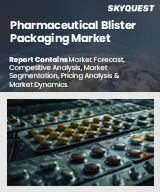
|
시장보고서
상품코드
1796448
의약품 블리스터 포장 시장 규모, 점유율, 성장 분석 : 제품 유형별, 기술 유형별, 재료 유형별, 용도별, 지역별 - 산업 예측(2025-2032년)Pharma Blisters Packaging Market Size, Share, and Growth Analysis, By Product Type (Clamshell, Carded), By Technology Type (Cold Forming, Thermoforming), By Material Type, By Application, By Region - Industry Forecast 2025-2032 |
||||||
세계의 의약품 블리스터 포장 시장 규모는 2023년에 275억 달러로 평가되며, 2024년 292억 3,000만 달러에서 2032년에는 476억 6,000만 달러로 성장하며, 예측 기간(2025-2032년)의 CAGR은 6.3%로 성장할 전망입니다.
세계 의약품 블리스터 포장 시장은 만성질환의 유병률 증가, 건강 인식 증가, 처방약 수요 증가 등의 요인으로 인해 크게 성장하고 있습니다. 이러한 성장을 지원하는 주요 동향에는 의약품의 안전성, 편의성 중시, 장벽이 높은 포장 솔루션으로의 전환 등이 있습니다. 또한 지속가능한 포장재로의 전환은 소비자의 기대치를 변화시키고 제약회사가 친환경적인 선택지를 채택하도록 유도하고 있습니다. 블리스터 포장을 포장 수탁기관(CPO)에 아웃소싱하는 것도 비용 절감과 업무 효율화를 위해 선호되고 있습니다. 하지만, 특히 알루미늄과 PVC의 재료 가격 변동과 친환경 대체재 채택에 따른 높은 비용 등의 문제에 직면해 있으며, 이는 기술 혁신과 시장 전반의 성장을 저해하는 요인으로 작용하고 있습니다.
목차
서론
- 조사의 목적
- 조사 범위
- 정의
조사 방법
- 정보 조달
- 1차와 2차 데이터 방법
- 시장 규모 예측
- 시장의 전제조건과 제한
개요
- 세계 시장 전망
- 공급과 수요 동향 분석
- 부문별 기회 분석
시장 역학과 전망
- 시장 개요
- 시장 규모
- 시장 역학
- 촉진요인과 기회
- 억제요인과 과제
- Porter의 산업 분석
주요 시장 인사이트
- 주요 성공 요인
- 경쟁의 정도
- 주요 투자 기회
- 시장 에코시스템
- 시장의 매력 지수(2024년)
- PESTEL 분석
- 거시경제 지표
- 밸류체인 분석
- 가격 분석
- 사용 사례
- 고객 구매 행동 분석
의약품 블리스터 포장 시장 규모 : 제품 유형별 & CAGR(2025-2032년)
- 시장 개요
- 클램쉘
- 카드
의약품 블리스터 포장 시장 규모 : 기술 유형별 & CAGR(2025-2032년)
- 시장 개요
- 냉간 성형
- 열성형
의약품 블리스터 포장 시장 규모 : 재료 유형별 & CAGR(2025-2032년)
- 시장 개요
- 폴리에틸렌 테레프탈레이트(PET, PETE, PETG 또는 폴리에스테르)
- 고밀도 폴리에틸렌(HDPE)
- 폴리염화비닐(PVC)
- 저밀도 폴리에틸렌(LDPE)
- 알루미늄
- 종이와 판지
의약품 블리스터 포장 시장 규모 : 용도별 & CAGR(2025-2032년)
- 시장 개요
- 정제
- 캡슐
- 분말
- 의료기기
의약품 블리스터 포장 시장 규모 & CAGR(2025-2032년)
- 북미
- 미국
- 캐나다
- 유럽
- 독일
- 스페인
- 프랑스
- 영국
- 이탈리아
- 기타 유럽
- 아시아태평양
- 중국
- 인도
- 일본
- 한국
- 기타 아시아태평양
- 라틴아메리카
- 브라질
- 기타 라틴아메리카
- 중동 및 아프리카
- GCC 국가
- 남아프리카공화국
- 기타 중동 및 아프리카
경쟁 정보
- 상위 5사의 비교
- 주요 기업의 시장 포지셔닝(2024년)
- 주요 시장 기업이 채택한 전략
- 최근 시장 동향
- 기업의 시장 점유율 분석(2024년)
- 주요 기업의 기업 개요
- 기업의 상세
- 제품 포트폴리오 분석
- 기업의 부문별 점유율 분석
- 매출의 전년대비 비교(2022-2024년)
주요 기업 개요
- Huhtamaki
- Alufoil Products
- Berry Global
- Plastoform Industry
- RPC Group
- Silgan Holdings
- Sonoco Products
- Amcor
- Mondi Group
- Greif
- Ardagh Group
- Sealed Air
결론과 제안
KSA 25.08.29Global Pharma Blisters Packaging Market size was valued at USD 27.5 billion in 2023 and is poised to grow from USD 29.23 billion in 2024 to USD 47.66 billion by 2032, growing at a CAGR of 6.3% during the forecast period (2025-2032).
The global pharma blisters packaging market is experiencing significant growth driven by factors such as the rising prevalence of chronic diseases, increased health awareness, and the growing demand for prescription pharmaceuticals. Key trends supporting this expansion include a strong emphasis on drug safety, convenience, and a shift towards high-barrier packaging solutions. Additionally, the move towards sustainable packaging materials is transforming consumer expectations, propelling pharmaceutical companies to adopt eco-friendly options. Outsourcing blister packaging to contract packaging organizations (CPOs) is also gaining traction for cost reduction and operational efficiency. However, the market faces challenges like fluctuating material prices, particularly for aluminum and PVC, along with the high costs associated with adopting eco-friendly alternatives, which can hinder innovation and overall market growth.
Top-down and bottom-up approaches were used to estimate and validate the size of the Global Pharma Blisters Packaging market and to estimate the size of various other dependent submarkets. The research methodology used to estimate the market size includes the following details: The key players in the market were identified through secondary research, and their market shares in the respective regions were determined through primary and secondary research. This entire procedure includes the study of the annual and financial reports of the top market players and extensive interviews for key insights from industry leaders such as CEOs, VPs, directors, and marketing executives. All percentage shares split, and breakdowns were determined using secondary sources and verified through Primary sources. All possible parameters that affect the markets covered in this research study have been accounted for, viewed in extensive detail, verified through primary research, and analyzed to get the final quantitative and qualitative data.
Global Pharma Blisters Packaging Market Segments Analysis
Global Pharma Blisters Packaging Market is segmented by Product Type, Technology Type, Material Type, Application and region. Based on Product Type, the market is segmented into Clamshell and Carded. Based on Technology Type, the market is segmented into Cold Forming and Thermoforming. Based on Material Type, the market is segmented into Polyethylene Terephthalate (PET, PETE, PETG or polyester), High Density Polyethylene (HDPE), Polyvinyl Chloride (PVC), Low-Density Polyethylene (LDPE), Aluminum and Paper & Paper Board. Based on Application, the market is segmented into Tablets, Capsules, Powders and Medical Devices. Based on region, the market is segmented into North America, Europe, Asia Pacific, Latin America and Middle East & Africa.
Driver of the Global Pharma Blisters Packaging Market
The increasing prevalence of chronic diseases such as diabetes, cardiovascular issues, and respiratory conditions significantly drives the expansion of the global pharmaceutical blisters packaging market. Blister packaging enhances medication adherence by simplifying the process for patients to manage their prescriptions, while also providing a secure and organized way to store medications. This is particularly beneficial for elderly individuals and those receiving home care. As the global population continues to face a rising number of chronic health conditions, the demand for packaging solutions that are not only safe and user-friendly but also tamper-evident is steadily increasing, fueling ongoing market growth.
Restraints in the Global Pharma Blisters Packaging Market
The global pharma blisters packaging market faces significant challenges due to the volatility of essential raw material prices, including aluminum, PVC, and various plastic polymers. These materials are crucial for producing blister packs, and unpredictable price fluctuations disrupt production planning and negatively impact profitability. Such instability complicates the establishment of long-term supply agreements, hindering investment in innovation, particularly for small and medium-sized packaging firms. This ongoing uncertainty regarding costs creates obstacles to market expansion and increases pressures on companies to adapt, ultimately affecting the growth potential of the industry as a whole.
Market Trends of the Global Pharma Blisters Packaging Market
The Global Pharma Blisters Packaging market is witnessing a significant trend towards sustainable packaging solutions, as pharmaceutical companies increasingly adopt eco-friendly materials like recyclable polymers, bio-based films, and paper-based substitutes. This shift is largely influenced by evolving regulations and growing consumer demand for environmentally responsible products. As a result, the industry is seeing a surge of innovation in packaging materials designed not only to maintain product integrity and safety but also to minimize environmental impact. This trend underscores a broader commitment within the pharmaceutical sector to enhance sustainability, ultimately shaping market dynamics and influencing purchasing decisions.
Table of Contents
Introduction
- Objectives of the Study
- Scope of the Report
- Definitions
Research Methodology
- Information Procurement
- Secondary & Primary Data Methods
- Market Size Estimation
- Market Assumptions & Limitations
Executive Summary
- Global Market Outlook
- Supply & Demand Trend Analysis
- Segmental Opportunity Analysis
Market Dynamics & Outlook
- Market Overview
- Market Size
- Market Dynamics
- Drivers & Opportunities
- Restraints & Challenges
- Porters Analysis
- Competitive rivalry
- Threat of substitute
- Bargaining power of buyers
- Threat of new entrants
- Bargaining power of suppliers
Key Market Insights
- Key Success Factors
- Degree of Competition
- Top Investment Pockets
- Market Ecosystem
- Market Attractiveness Index, 2024
- PESTEL Analysis
- Macro-Economic Indicators
- Value Chain Analysis
- Pricing Analysis
- Case Studies
- Customer Buying Behavior Analysis
Global Pharma Blisters Packaging Market Size by Product Type & CAGR (2025-2032)
- Market Overview
- Clamshell
- Carded
Global Pharma Blisters Packaging Market Size by Technology Type & CAGR (2025-2032)
- Market Overview
- Cold Forming
- Thermoforming
Global Pharma Blisters Packaging Market Size by Material Type & CAGR (2025-2032)
- Market Overview
- Polyethylene Terephthalate (PET, PETE, PETG or polyester)
- High Density Polyethylene (HDPE)
- Polyvinyl Chloride (PVC)
- Low-Density Polyethylene (LDPE)
- Aluminum
- Paper & Paper Board
Global Pharma Blisters Packaging Market Size by Application & CAGR (2025-2032)
- Market Overview
- Tablets
- Capsules
- Powders
- Medical Devices
Global Pharma Blisters Packaging Market Size & CAGR (2025-2032)
- North America (Product Type, Technology Type, Material Type, Application)
- US
- Canada
- Europe (Product Type, Technology Type, Material Type, Application)
- Germany
- Spain
- France
- UK
- Italy
- Rest of Europe
- Asia Pacific (Product Type, Technology Type, Material Type, Application)
- China
- India
- Japan
- South Korea
- Rest of Asia-Pacific
- Latin America (Product Type, Technology Type, Material Type, Application)
- Brazil
- Rest of Latin America
- Middle East & Africa (Product Type, Technology Type, Material Type, Application)
- GCC Countries
- South Africa
- Rest of Middle East & Africa
Competitive Intelligence
- Top 5 Player Comparison
- Market Positioning of Key Players, 2024
- Strategies Adopted by Key Market Players
- Recent Developments in the Market
- Company Market Share Analysis, 2024
- Company Profiles of All Key Players
- Company Details
- Product Portfolio Analysis
- Company's Segmental Share Analysis
- Revenue Y-O-Y Comparison (2022-2024)
Key Company Profiles
- Huhtamaki
- Company Overview
- Business Segment Overview
- Financial Updates
- Key Developments
- Alufoil Products
- Company Overview
- Business Segment Overview
- Financial Updates
- Key Developments
- Berry Global
- Company Overview
- Business Segment Overview
- Financial Updates
- Key Developments
- Plastoform Industry
- Company Overview
- Business Segment Overview
- Financial Updates
- Key Developments
- RPC Group
- Company Overview
- Business Segment Overview
- Financial Updates
- Key Developments
- Silgan Holdings
- Company Overview
- Business Segment Overview
- Financial Updates
- Key Developments
- Sonoco Products
- Company Overview
- Business Segment Overview
- Financial Updates
- Key Developments
- Amcor
- Company Overview
- Business Segment Overview
- Financial Updates
- Key Developments
- Mondi Group
- Company Overview
- Business Segment Overview
- Financial Updates
- Key Developments
- Greif
- Company Overview
- Business Segment Overview
- Financial Updates
- Key Developments
- Ardagh Group
- Company Overview
- Business Segment Overview
- Financial Updates
- Key Developments
- Sealed Air
- Company Overview
- Business Segment Overview
- Financial Updates
- Key Developments


















